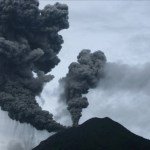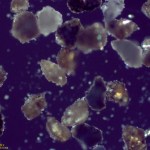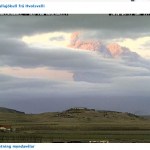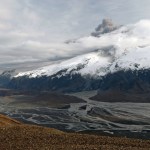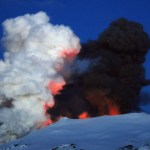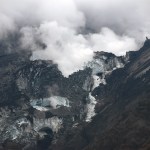aviation
USA Science & Engineering Festival X-STEM Speaker renowned aviator Barrington Irving sums up his current mission as a role model this way: "Kids want to be challenged, but today too many are bored and uninspired. I want to use aviation to excite and empower a new generation to become scientists, engineers, and explorers."
He has a lot to inspire kids about. Born in Jamaica and raised in Miami Florida's inner city, surrounded by crime, poverty, and failing schools, he beat the odds in 2007 when, at the age of 23, he became the youngest person ever (and only African American) to pilot a…
Classes starting today, so I have to be brief:
Unique twin ash plumes from Sinabung in Indonesia, erupting on August 29, 2010.
Sinabung
The Indonesian volcano continues to experience explosions, which one last night (well, last night here in Ohio) that prompted an ash advisory for aircraft up to 6,100 m / 20,000 feet, although most reports I've seen pegged the ash column at closer to 2,000 m / ~6,500 feet. Eruptions readers have found a bevy of links for footage and information about the eruption, including a remarkable image gallery from the BBC that shows the volcano exhibiting two ash…
Eyjafjallajökull erupting in the spring of 2010.
I have a request for all of you Eruptions readers! In a few weeks I will be giving a talk here at Denison on the Eyjafjallajökull eruption and especially the aspects of how the eruption unfolded on the web. I think the shared experience of the seismicity, fissure vent eruption and explosive eruption - along with all the ramifications of the air traffic stoppage over Europe - was a fascinating phenomenon. So, I ask you readers: How would you describe your experience on Eruptions during the Eyjafjallajökull events? By that I mean in terms of…
Lots of little pieces of news I've run across ... time to play a little catch up.
Stromboli: A volcano after Don Ho's heart.
Every once in a while, my RSS feeds will dredge up some articles from years gone by ... and this week there were two New York Times pieces that are a few years old, but interesting nevertheless. The first is about research conducted by Dr. Robert Sohn at WHOI on explosive undersea eruptions. The second is work by Corr and Vaughan about finding subglacial volcanism in Antarctica. Both are interesting reads if you missed them (like I did) the first time around.…
Quick hits to wrap up the week:
Looking into a skylight at Kilauea. Image taken July 8, 2010, courtesy of HVO/USGS.
Following up some news about Changbaishan/Changbai caldera in North Korea, Yang Qingfu, director of earthquake and volcano analysis and forecast center with the seismology bureau of northeast China's Jilin Province, says that the volcano appears to be quiet and that there are no signs of an impending eruption - at least not in the next dozen years. The bigger news (in my mind) is that China will be installing full monitoring (gravity, deformation, electromagnetics, fluid…
News!
The summit crater lake at Gorely in Russia, taken on June 21, 2010. Image courtesy of KVERT.
Eruptions readers have been abuzz about how KVERT will be closing shop (yet again) at the end of June. This would, of course, leave no local monitoring and expertise in the very active Kamchatka Peninsula and Kuril Islands in Russia. Right now Shiveluch and Gorely are both showing signs of increased eruption (along with other volcanoes in the arc). In fact, Gorely, which hasn't erupted since 1986, looks primed to have an eruption, with increased tremors, steam-and-gas emissions and a new…
Africa is threatened by "scorching hot blobs of magma" according to the CSM.
Nothing like some fabulous headlines to make your day.
The first (courtesy of the Christian Science Monitor)
Massive blob of scorching magma discovered under southern Africa
Oh my! Yes, again, it seems that the many people in the media seem to be very confused about the nature of magma when it is underground - always expecting giant vats of swirling, molten magma rising up to destroy us all. Very few have a good sense of the real state of the Earth's mantle - mostly solid. The article is in fact about a recent study…
Looking for some volcano news - you've found it.
A shot of volcano "tourists" near the erupting Pacaya. Photo by the Associated Press.
Eruptions reader Dr. Boris Behncke dropped a note that Kilauea has not one but two active lava lakes right now. The lava lakes can be seen on the webcams for the Halema`uma`u Crater and the Pu`u O`o flank vent. The latest status update from June 6th by the USGS Hawaiian Volcano Observatory talks about both the summit and rift activity (video) on Kilauea as well. Meanwhile, Hawaii 24/7 has a piece in the Volcano Watch series about whether residents of Maui…
Undated image of Bezymianny in Kamchatka.
Eruptions reader M. Randolph Kruger just let us in on a significant eruption at Bezymianny in Kamchatka. The AVO/KVERT alert for the volcano suggests a fairly significant explosive eruption that might cause some snarls in the international air travel over the Kamchatka Peninsula. The KVERT statement:
A strong explosive eruption of Bezymianny volcano occurred from 12:34 till 12:50 UTC on May 31, according to seismic data. Ash fall in Kozyrevsk village is continuing. The volcano obscured by clouds. A big ash cloud remains over Kamchatka at present (…
Quick news on Memorial Day (in the US at least):
Ash soaked by rain from Tropical Storm Agatha on the roofs of homes in Guatemala after the late May eruption of Pacaya.
Sixteen scientists were evacuated from islands in the northern Marianas due to the eruption of the unnamed submarine volcano south of Sarigan Island. The eruption is continuing to be monitored closely by the USGS and National Weather Service as the plume - which is most steam with minor ash - could disrupt air traffic in/around Saipan. The latest USGS CNMI update:
Seismicity at a single nearby station on Sarigan Island…
Dark ash covers an American Airline 737 on the tarmac at the airport in Guatemala City.
Two volcanoes are making headlines right now (and neither is in Iceland).
As I mentioned yesterday, Pacaya in Guatemala erupted (video) causing widespread disruption of life in the nearby Guatemala City and costing two people their lives (including a TV reporter who got too close to the vent). Almost 2,000 people have been evacuated from the region near the volcano. The BBC has posted some impressive video of the eruption of Pacaya, showing the strombolian explosions sending basaltic tephra high into the…
This week has been destroyed by workshops and my last death throes with a paper I am submitting on my research in New Zealand. And to think, I thought it might settle down a little after the students left.
To news!
Ash fall on a taxi cab near Guatemala's Pacaya.
Pacaya in Guatemala erupted yesterday causing evacuations of people near the volcano and the closure of Guatemala City's main airport. Pacaya is a mere ~25 km from the capitol of this Central American nation. Tragically, a news reporter from one of the capitol's TV stations died when they were struck by volcanic debris, again…
The ash plume from Eyjafjallajökull, piercing the cloud deck above the volcano. Image courtesy of the Icelandic Met Office, taken on May 13, 2010. See the latest report on the eruption.
With all the rapid fire news on eruptions as of late, combined with my busy schedule during the school year, I haven't been able to post as many articles on some basic aspects of volcanology. I will try to remedy some of this over the summer and the first will look at volcanic ash and specifically the ash from Eyjafjallajökull. I've taken some photomicrographs of the ash from Eyjafjallajökull (sent to me…
News, news, news!
Ash from Eyjafjallajökull piling up on a roof at Seljavellir. Image courtesy of the IMO, by Ari Tryggvason.
The latest from Eyjafjallajökull has the volcano continuing to puff away - producing intermittent airspace closures over Europe. The Icelandic Met Office reports a ~7 km (21,000 foot) ash plume, but they note that the explosivity of the eruption seems to have waned some since a maximum on May 13. Right now, the IMO estimates the eruption rate at ~200 tonnes/second. Lets put that in a little perspective - a Ford F-150 pickup weighs about 2 tonnes, so the volcano is…
Some news for a sleepy Monday:
Mt. Hood in Oregon.
The ash from Eyjafjallajökull is, once again, causing significant airspace closure over northern Europe - close of 1,000 flights today. However, much of the closures are fairly short-lived, but that isn't keeping people happy. The eruption hasn't actually changed much, just that the winds are bringing ash towards Europe. The ash for the next few days will likely effect the England, Scotland, Ireland, Netherlands, France and possibly other parts of northern Europe (along with airspace over Greenland and the north Atlantic). The ash plume is…
Time to play a little catch up ...
Eyjafjallajökull erupting in early May. Image by and courtesy of Martin Rietze.
A brief update on our friend Eyjafjallajökull - the eruption plume from the volcano was considerably taller yesterday, reaching 6-9 km (20,000-30,000 feet), but prevailing winds meant the ash hazard was confined to areas in the middle of the North Atlantic and northern parts of the British Isles. However, even as the ash hazard for Europe wanes (for now), you shouldn't forget the amount of ash being dumped on parts of Iceland. If you want to see some stunning images of the…
An aerial view of Eyjafjallajökull erupting on May 11, 2010, with the extent of the black ash from the eruption on GÃgjökull clearly evident, along with the cracks in the glacier near the lava flow. Photo from the Icelandic Met Office, by Sigurlaug Hjaltadóttir.
Since this past weekend's disruptions due to Eyjafjallajökull, the air over Europe has cleared and most of the airports in Spain, Portugal and Germany (along with those in Morocco) have reopened. The current ash advisory by the London VAAC looks like it will only effect transatlantic flights and Iceland itself, with the ash cloud…
I an in the home stretch for grading exams, so just a quick update for today:
The evidence of floods from the Eyjafjallajökull eruption, taken on May 1, 2010 by Dr. Joe Licciardi.
Airports now as far south as Spain, Morocco and the Canary Islands are facing closures due to the Eyjafjallajökull ash. The latest London VAAC ash advisory has the ash wrapping around western and southern Europe, which I am sure is making life interesting for routing transatlantic flights into Europe. The flights within Europe don't seem to be that effected according to Eurocontrol - and they have even dropped…
A shot of the summit area of Eyjafjallajökull, showing the twin steam-and-ash plumes from the lava flow and active vent. Picture taken by Dr. Joseph Licciardi (UNH).
Over the weekend, the newly reinvigorated ash eruptions from Eyjafjallajökull combined with favorable winds meant that ash from the eruption closed airspace over swaths of Europe, including Ireland, Spain, Portugal, Italy, Austria and Germany. These disruptions are continuing into the new week, although most of the disruption is for transatlantic flights. However, the threat of ash is more present than ever, as Ryanair…
The GÃgjökull outlet glacier on Eyjafjallajökull, showing the steaming lava flow carving its way through the glacier. Image taken May 5, 2010 by Dr. Joseph Licciardi.
A quick update on the ongoing activity at Eyjafjallajökull:
The activity at the volcano continues to be more explosive during the last few days than it was in the previous week, leading to more potential for airspace closures over Europe if the winds were to shift. Currently, the VAAC ash advisory only seems to suggest that even Spain may get a taste of the ash sometime tomorrow, but most of Europe will be OK. However,…

